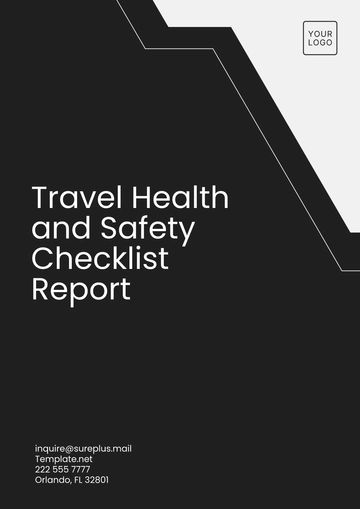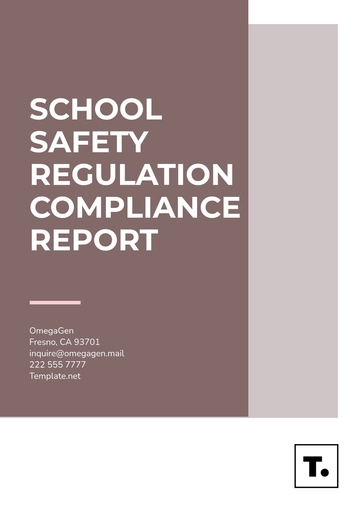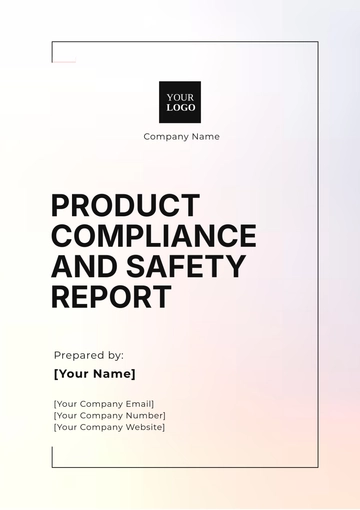Free Nursing Home Safety Report

I. Executive Summary
At [Your Company Name], we are dedicated to upholding the highest standards of care and safety for all our residents. This Safety Report is a testament to our unwavering commitment to transparency, accountability, and continuous improvement in our operations. Within this report, we present the findings from our comprehensive safety assessment, including areas where we excel and opportunities for enhancement.
Key findings highlight our strengths in maintaining exceptional sanitation and hygiene practices, robust infection control measures, and diligent staff training programs. However, we also recognize the need for improvements in emergency preparedness, secure storage practices, and enhanced navigational aids for our residents with cognitive impairments.
Based on our findings, we have formulated a series of recommendations aimed at addressing these areas. These include immediate actions to secure all cleaning supply storage areas, short-term improvements to our emergency response training and signage, and long-term investments in advanced safety technologies.
Our goal is not only to meet but to exceed the expectations of our residents, their families, and regulatory bodies. We see this report as a critical step in our journey toward becoming a beacon of excellence in nursing home care. We are fully committed to implementing these recommendations and continuously seeking ways to enhance the safety and well-being of our cherished community.
II. Introduction
Welcome to [Your Company Name]'s Safety Report. As a trusted provider of nursing home care, we are deeply committed to the safety, health, and well-being of our residents. This report reflects our ongoing efforts to not only adhere to established safety standards but to exceed them, ensuring that our home remains a secure and nurturing environment. In this document, we outline our methodologies, findings, and the steps we are taking to address areas of improvement. Our mission is clear: to provide unparalleled care through continuous improvement and unwavering dedication to our residents' safety and quality of life.
III. Methodology
Our self-assessment was meticulously designed to cover all aspects of our operations. Through comprehensive on-site inspections, engaging discussions with our staff and residents, and a thorough review of our policies and past incident reports, we've gathered a wealth of information. This process allowed us to examine our practices critically, celebrate our successes, and identify opportunities for enhancement. Our aim was to ensure transparency and objectivity throughout, providing a reliable foundation for our ongoing improvement efforts.
IV. Safety Assessment Findings
A. Physical Environment
Sanitation and Hygiene Practices
At our establishment, we take great pride in the rigorous standards we maintain when it comes to cleanliness and hygiene. These factors play a crucial role in the prevention of infections, establishing their importance. As a part of our ongoing efforts to enhance our standards, we have identified room for growth in one particular area. This area pertains to how we secure our storage for cleaning materials and supplies. We have recognized the need to bolster our methods and tighten our security measures to prevent accidental or unintended access to these cleaning supplies.
B. Resident Safety
Infection Control Measures
Within our healthcare institution, we have instituted a robust set of procedures aimed at controlling and preventing the spread of infections. Looking ahead into the future, we are formulating plans to bolster our screening procedures for visitors coming into our facility. This move is part of our concerted efforts aimed at ensuring additional layers of protection for our healthcare community and all those who interface with the facility.
C. Staffing
Background Checks and Safety Training for Staff
All of our staff members are subject to thorough background checks and are provided with in-depth safety training. It is our acknowledgment and understanding that there is an ongoing need for more frequent and comprehensive training sessions. These sessions are particularly focusing on emergency response procedures and techniques for resident care that will enhance the quality of service we provide.
D. Policies and Procedures
Compliance with Local and National Safety Standards
We maintain an unwavering commitment to adhering to safety standards. We understand and fully acknowledge the key significance of careful and detailed documentation of every aspect of training and drills. This is crucial for ensuring that we consistently comply with all the necessary standards while also striving towards constant enhancement and improvement in our practices.
V. Case Studies and Examples
A. Case Study 1: Successful Influenza Outbreak Containment
In the winter of [Year], [Your Company Name] faced a potential influenza outbreak. Swift action and adherence to our infection control protocols were pivotal in containing the virus.
Challenge: An influx of influenza cases in the local community posed a significant risk to our residents.
Action Taken: We immediately isolated affected residents, increased sanitation measures, and administered antiviral medications as a preventative measure to all residents and staff.
Outcome: The outbreak was contained with only three confirmed cases within our facility, none of which led to severe complications, thanks to our rapid response and effective infection control measures.
Lessons Learned: Continuous staff training and preparedness for infectious disease outbreaks are crucial in protecting our vulnerable population.
B. Case Study 2: Emergency Evacuation During a Power Outage
An unexpected power outage tested our emergency response capabilities, revealing areas for improvement in staff training and equipment readiness.
Challenge: A severe storm caused a prolonged power outage, necessitating the evacuation of several residents from their rooms.
Action Taken: Staff initiated the evacuation protocol; however, difficulties arose due to unfamiliarity with backup power sources and evacuation chairs.
Outcome: All residents were safely evacuated, but the process took longer than ideal, causing distress among some residents.
Lessons Learned: Practical, hands-on training in emergency procedures and equipment use is essential for ensuring staff confidence and efficiency during real-life emergencies.
VI. Recommendations
Based on our comprehensive safety assessment and the insights gained from our case studies, we propose the following targeted actions and strategic improvements:
A. Immediate Actions
Secure Storage Areas for Cleaning Supplies: Implement locks and conduct regular audits to ensure these areas remain inaccessible to unauthorized individuals.
Action Item | Responsibility | Completion Date |
|---|---|---|
Install locks on all storage areas | Facilities Manager | [Date] |
Conduct monthly storage area audits | Safety Compliance Team | Ongoing |
Enhance Visitor Screening Processes: Introduce more rigorous health screening procedures for visitors during peak infectious disease periods.
Action Item | Responsibility | Completion Date |
|---|---|---|
Implement health questionnaire | Front Desk Staff | [Date] |
Install temperature screening stations | Facilities Management | [Date] |
B. Short-term Improvements
Improve Navigational Signage: Upgrade signage throughout the facility to assist residents with cognitive impairments.
Action Item | Responsibility | Completion Date |
|---|---|---|
Audit current signage effectiveness | Occupational Therapy Team | [Date] |
Install new signage as per the audit | Facilities Management | [Date] |
Enhance Emergency Response Training: Develop and implement a hands-on emergency response training program for all staff.
Action Item | Responsibility | Completion Date |
|---|---|---|
Develop a hands-on training curriculum | Training Department | [Date] |
Conduct quarterly emergency response drills | Safety Officer | Ongoing |
C. Long-term Strategies
Invest in Advanced Safety Technologies: Upgrade our facilities with the latest in safety technology, focusing on fire detection and resident monitoring.
Strategy | Responsibility | Estimated Completion |
|---|---|---|
Install advanced fire detection systems | Facilities Management | [Date] |
Implement non-invasive monitoring solutions | IT Department | [Date] |
Infrastructure Upgrades for Enhanced Safety: Plan and execute renovations to improve overall facility safety and accessibility.
Strategy | Responsibility | Estimated Completion |
|---|---|---|
Renovate areas to improve accessibility | Facilities Management | [Date] |
Upgrade lighting and security systems | Facilities Management | [Date] |
These actions, derived from our continuous self-assessment and the invaluable lessons learned from our case studies, are integral to our commitment to maintaining the highest standards of safety and care for our residents. [Your Company Name] is dedicated to implementing these recommendations, with a steadfast commitment to safety, transparency, and excellence in care.
VII. Conclusion
Our comprehensive safety assessment, underscored by the detailed case studies within this report, has illuminated both the strengths and areas for improvement in [Your Company Name]'s operations. Through this introspective process, we have affirmed our commitment to not just maintaining, but continually elevating the standards of care and safety for our residents. The key takeaways from our endeavor include:
Proactive Infection Control Is Critical: Our successful containment of the influenza outbreak demonstrates the effectiveness of our infection control protocols. This achievement underlines the importance of maintaining high standards of hygiene and quick response to potential health threats.
Emergency Preparedness Requires Hands-on Training: The challenges encountered during the power outage evacuation highlighted the need for practical, hands-on emergency response training. Ensuring that all staff are confident and knowledgeable in the use of emergency equipment and procedures is essential.
Continuous Improvement Is a Journey: The insights gained from our safety assessment and case studies have prompted a series of immediate actions, short-term improvements, and long-term strategic initiatives. These efforts are geared towards not only addressing the identified areas of concern but also towards setting new benchmarks in nursing home safety and care.
Investment in Advanced Technologies and Infrastructure: Our commitment to safety and excellence compels us to look forward, to planning significant investments in advanced safety technologies and infrastructure upgrades. These initiatives are envisioned to enhance the living environment of our residents, making it safer and more comfortable.
Engagement and Transparency with Our Community: This report is a testament to our dedication to transparency and accountability. By openly sharing our findings, actions, and visions for the future, we aim to foster a culture of trust and partnership with our residents, their families, and the broader community.
In conclusion, [Your Company Name] recognizes that ensuring the safety and well-being of our residents is an ongoing responsibility that requires vigilance, dedication, and adaptability. The steps outlined in this report reflect our holistic approach to safety, encompassing not just physical well-being but also the mental and emotional health of our residents. As we move forward, we are inspired by the lessons learned and motivated by our unwavering commitment to providing a safe, nurturing home for all our residents. Our journey of continuous improvement is propelled by our core values, guided by our findings, and enriched by our community's feedback. We embrace this journey with enthusiasm and confidence in our ability to achieve our vision of setting the gold standard in nursing home care and safety.
- 100% Customizable, free editor
- Access 1 Million+ Templates, photo’s & graphics
- Download or share as a template
- Click and replace photos, graphics, text, backgrounds
- Resize, crop, AI write & more
- Access advanced editor
Elevate your safety standards with Template.net's Nursing Home Safety Report Template. Designed for meticulous safety audits and reporting, this template is fully customizable and editable using our Ai Editor Tool. Document and analyze safety incidents, implement corrective actions and promote a culture of safety. An essential tool for maintaining a secure environment, exclusively available at Template.net.
You may also like
- Sales Report
- Daily Report
- Project Report
- Business Report
- Weekly Report
- Incident Report
- Annual Report
- Report Layout
- Report Design
- Progress Report
- Marketing Report
- Company Report
- Monthly Report
- Audit Report
- Status Report
- School Report
- Reports Hr
- Management Report
- Project Status Report
- Handover Report
- Health And Safety Report
- Restaurant Report
- Construction Report
- Research Report
- Evaluation Report
- Investigation Report
- Employee Report
- Advertising Report
- Weekly Status Report
- Project Management Report
- Finance Report
- Service Report
- Technical Report
- Meeting Report
- Quarterly Report
- Inspection Report
- Medical Report
- Test Report
- Summary Report
- Inventory Report
- Valuation Report
- Operations Report
- Payroll Report
- Training Report
- Job Report
- Case Report
- Performance Report
- Board Report
- Internal Audit Report
- Student Report
- Monthly Management Report
- Small Business Report
- Accident Report
- Call Center Report
- Activity Report
- IT and Software Report
- Internship Report
- Visit Report
- Product Report
- Book Report
- Property Report
- Recruitment Report
- University Report
- Event Report
- SEO Report
- Conference Report
- Narrative Report
- Nursing Home Report
- Preschool Report
- Call Report
- Customer Report
- Employee Incident Report
- Accomplishment Report
- Social Media Report
- Work From Home Report
- Security Report
- Damage Report
- Quality Report
- Internal Report
- Nurse Report
- Real Estate Report
- Hotel Report
- Equipment Report
- Credit Report
- Field Report
- Non Profit Report
- Maintenance Report
- News Report
- Survey Report
- Executive Report
- Law Firm Report
- Advertising Agency Report
- Interior Design Report
- Travel Agency Report
- Stock Report
- Salon Report
- Bug Report
- Workplace Report
- Action Report
- Investor Report
- Cleaning Services Report
- Consulting Report
- Freelancer Report
- Site Visit Report
- Trip Report
- Classroom Observation Report
- Vehicle Report
- Final Report
- Software Report





























